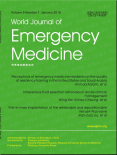- 钛学术文献服务平台 \
- 学术期刊 \
- 医药卫生期刊 \
- 临床医学期刊 \
- 世界急诊医学杂志(英文)期刊 \
The expression of oxidative stress genes related to myocardial ischemia reperfusion injury in patients with ST-elevation myocardial infarction
The expression of oxidative stress genes related to myocardial ischemia reperfusion injury in patients with ST-elevation myocardial infarction
基本信息来源于合作网站,原文需代理用户跳转至来源网站获取
摘要:
BACKGROUND: We aimed to investigate the gene expression of myocardial ischemia/reperfusion injury (MIRI) in patients with acute ST-elevation myocardial infarction (STEMI) using stress and toxicity pathway gene chip technology and try to determine the underlying mechanism.METHODS: The mononuclear cells were separated by ficoll centrifugation, and plasma total antioxidant capacity (T-AOC) was determined by the ferric reducing ability of plasma (FRAP) assay. The expression of toxic oxidative stress genes was determined and verified by oligo gene chip and quantitative real-time polymerase chain reaction (qRT-PCR). Additionally, gene ontology (GO) enrichment analysis was performed on DAVID website to analyze the potential mechanism further. RESULTS: The total numbers of white blood cells (WBC) and neutrophils (N) in the peripheral blood of STEMI patients (the AMI group) were significantly higher than those in the control group (WBC: 11.67±4.85 ×109/L vs. 6.41±0.72 ×109/L, P<0.05; N: 9.27±4.75 ×109/L vs. 3.89±0.81 ×109/L, P<0.05), and WBCs were significantly associated with creatine kinase-myocardial band (CK-MB) on the first day (Y=8.945+0.018X, P<0.05). In addition, the T-AOC was significantly lower in the AMI group comparing to the control group (12.80±1.79 U/mL vs. 20.48±2.55 U/mL, P<0.05). According to the gene analysis, eight up-regulated differentially expressed genes (DEGs) included GADD45A, PRDX2, HSPD1, DNAJB1, DNAJB2, RAD50, TNFSF6, and TRADD. Four down-regulated DEGs contained CCNG1, CAT, CYP1A1, and ATM. TNFSF6 and CYP1A1 were detected by polymerase chain reaction (PCR) to verify the expression at different time points, and the results showed that TNFSF6 was up-regulated and CYP1A1 was down-regulated as the total expression. GO and kyoto encyclopedia of genes and genomes (KEGG) enrichment analysis suggested that the oxidative stress genes mediate MIRI via various ways such as unfolded protein response (UPR) and apoptosis. CONCLUSIONS: WBCs, especially neutrophils, were the critical cells that mediating reperfusion injury. MIRI was regulated by various genes, including oxidative metabolic stress, heat shock, DNA damage and repair, and apoptosis-related genes. The underlying pathway may be associated with UPR and apoptosis, which may be the novel therapeutic target.

推荐文章
急性心肌梗死经皮腔内冠脉介入治疗后心电图 ST 段回落不良与临床预后的关系研究
急性 ST 段抬高型心肌梗死
经皮腔内冠脉介入治疗
STR
临床预后
心脏功能
阿托伐他汀序贯治疗对 ST段抬高型心肌梗死患者急诊PCI术后血清炎症因子水平及预后的影响
心肌梗死
经皮冠状动脉介入治疗
阿托伐他汀
预后
炎症因子
术中配合及护理对ST段抬高型心肌梗死病人介入治疗的应用效果
ST段抬高型急性心肌梗死
经皮冠状动脉介入治疗
术中配合
护理
内容分析
关键词云
关键词热度
相关文献总数
(/次)
(/年)
文献信息
| 篇名 | The expression of oxidative stress genes related to myocardial ischemia reperfusion injury in patients with ST-elevation myocardial infarction | ||
| 来源期刊 | 世界急诊医学杂志(英文版) | 学科 | |
| 关键词 | |||
| 年,卷(期) | 2022,(2) | 所属期刊栏目 | Original Articles |
| 研究方向 | 页码范围 | 106-113 | |
| 页数 | 8页 | 分类号 | |
| 字数 | 语种 | 中文 | |
| DOI | 10.5847/wjem.j.1920-8642.2022.021 | ||
五维指标
引文网络
引文网络
二级参考文献 (0)
共引文献 (0)
参考文献 (0)
节点文献
引证文献 (0)
同被引文献 (0)
二级引证文献 (0)
2022(0)
- 参考文献(0)
- 二级参考文献(0)
- 引证文献(0)
- 二级引证文献(0)
引文网络交叉学科
相关学者/机构
期刊影响力
世界急诊医学杂志(英文)
主办单位:
浙江大学/浙江大学医学院附属第二医院
出版周期:
季刊
ISSN:
1920-8642
CN:
33-1408/R
开本:
出版地:
杭州市解放路88号
邮发代号:
创刊时间:
语种:
chi
出版文献量(篇)
674
总下载数(次)
0
总被引数(次)
2282
期刊文献
相关文献
推荐文献

 免费查重
免费查重










